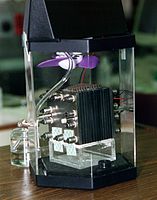
Photo from wikipedia
Abstract Due to eco-friendly production and running processes, direct methanol fuel cell has been considered as a clean and green energy generation technology. However, the dissatisfactory discharge performance of fuel… Click to show full abstract
Abstract Due to eco-friendly production and running processes, direct methanol fuel cell has been considered as a clean and green energy generation technology. However, the dissatisfactory discharge performance of fuel cell, mainly caused by low-efficient catalyst layers, has limited its commercialization. To improve the electrochemical active surface area, herein, the novel cathode catalyst layer with nanofiber microstructure has been prepared by adding water additive into the catalyst slurry, during the heat-spray process, for enhancing electrochemical performance of direct methanol fuel cells. In the catalyst slurry, owing to its high molecular polarity, the water phase collects polar parts of Nafion molecules, i.e. sulfonic acid group, together to form the polar region. Simultaneously, the nonpolar fluorocarbon chain spreads into an isopropanol phase to form the low-polar region. The distinction between polar and non-polar regions provides a structural basis for orderly mass transfer inside the catalyst layer. Finally, the novel catalyst layer exhibits a 34.7% increase in electrochemical active surface area and signally enhanced mass transport properties, leading to a 41.5% improvement in the power density of the fuel cell. This design to concurrently enhance electroactive surface area and build order mass transfer provides a new strategy for developing high-performance catalyst layers.
Journal Title: Energy Conversion and Management
Year Published: 2020
Link to full text (if available)
Share on Social Media: Sign Up to like & get
recommendations!